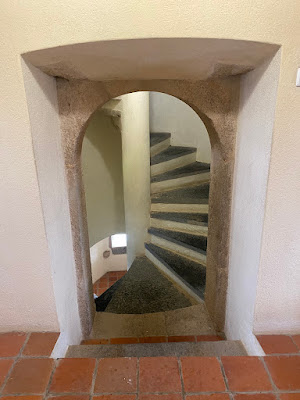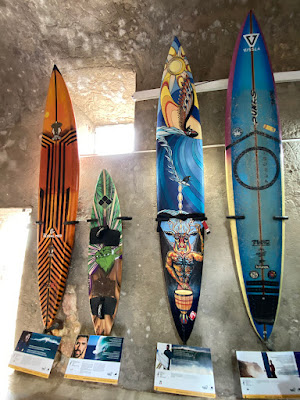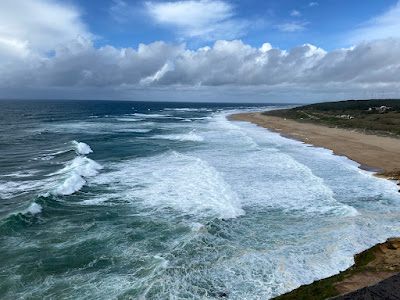PORTUGAL 2025
On a dogs breakfast day of weather we made our way from Évora to Óbidos.
March 7
The weather gave us a great opportunity to check out some castles without crowds, the first of our castle visits was Evoramonte.
Evoramonte had its first charter in 1248, renovated by King Afonso III in 1271. However, the difficulties in establishing a permanent population wishing to live here seemed not to go away. So, with the purpose of making Evoramonte inhabitants feel protected and wanted, King Dinis ordered the fortification of the medieval village in 1306. Although the walls of Castle of Evoramonte has suffered some alterations throughout the centuries, a lot of it is still original.























After walking through the entire castle grounds by ourselves, next up on Castle day was the town of Abrantes.
Castelo de Abrantes was built by King Afonso Henriques in the 11th century, the Abrantes Fortress played an important role as a strategic point in the defense of the Tagus Line (a row of defensive castles along the Tagus river) that the Knights Templar established to control and maintain the lands reconquered from the Muslims.
One popular legend of the castle involves the ghost of a Moorish princess who is said to haunt the castle. According to the tale, she was deeply in love with a Christian knight, and their tragic love story ended in heartbreak. Visitors sometimes claim to see her spirit wandering the castle grounds, especially on moonlit nights. Another myth involves hidden treasures buried within the castle walls, left by the Moors during their retreat. This legend has intrigued treasure hunters for generations, though no treasure has been found.




Another castle to explore by ourselves.













Our last castle stop of the day, was maybe the briefest.
Almoural Castle sits on a small island in the middle of the Tagus river. The origins of the occupation of this place are quite mysterious, but in 1129 the castle already existed and it was called Almorolan. Under the ruling of the Knights Templar the castle was rebuilt in 1171. With the extinction of the Order of the Knights Templar in Portugal the castle was somehow abandoned. It was not until the 19th century that the castle was reinvented according to a Romanticism ideal of the Medieval flair and was taken over as a residence of Portugal's dictator in the 20th century.


It was torrential rain when we arrived, and the little ferry that took you over to the castle was closed, so we sat in a little cafe overlooking the castle, had some drinks and Portuguese pastry while we waited for the rains to die down a bit.
There was no hope that it would re-open, so we started heading towards our final destination of Obidos, but we had one more stop to make, maybe the oldest of our entire trip, the Grutas Mira de Aire caves.
Grutas Mira de Aire caves. Discovered in 1947, the entrance to these caves is 300 meters high, but the interior reaches a depth of 180 meters. Their formation dates back 150 million years, to the Middle Jurassic. Throughout the 1960s, a series of walkways were built inside to allow access to groups of people, with the aim of exploiting it for tourism.









































It's a lot of stairs and walkways down, when you finally reach the end, they take you in an elevator back up to the surface. Turns out we must have covered a lot of territory, because where we come out is nowhere near where we parked and entered the structure. I turn around and go back to ask the staff where we go, and they are mysteriously gone.
It's pouring rain, and we eventually thought to use our Apple Airtags, and then figured out how to get to our luggage that's in the car. Even with umbrellas we are soaked by the time we get to the car. Turns out there was a blue painted line along the road leading back to the parking lot, but with the heavy rain you couldn't really see it.
We cranked the heater on in the car, and put our coats on the back seats to dry off as we drove on to Obidos.
Óbidos
Once a Roman town, Óbidos evolved over the years from it's stone age origins to the fall of Rome. Sometime after 713 the Moors established a fortification on this mountain, the city was taken from the Moors during the reign of the first King of Portugal, Afonso Henriques, in 1148. The walls of the city and the castle were remodelled in the 14th century,and had to be restored after the earthquake of 1755. More recently, the village was a centre of government and meeting place for the Armed Forces to plan their Coup in the 1974 Carnation Revolution, to overthrow the dictator and become a democracy.
Unlike the hotels and Inns that we had booked so far, in Óbidos we booked a place described as Charming Óbidos Townhouse. 2 bedrooms, 2 baths, kitchen, living room, large patio, and even laundry. we could wash our clothes, recharge, and the views were great.


The only challenging part was figuring out that we had to drive up this narrow entry way through the gates and into our private parking stall. Luckily for us I was now fully trained in narrow street stunt driving.






The views from our windows are of the castle and the walls that top the city.
In the pouring rain we went for dinner to the nearest restaurant, A Nova Casa de Ramiro. It was very cosy and quaint inside, the food was excellent, but they played the "please wait here in the lounge while we get a table ready" game. Twenty minutes later we got sat at the table that had been empty the whole time. Once sat, the service was excellent, and the owner was super friendly.






Long before we left home, I had made special arrangements to have a city tour in Porto in a Model T. Out of the blue he texts me and wants to reschedule to the next day. When I tell him we will look for something else, he says "OK, No problem, Thanks anyways".

I am not happy, but was able to find a different guide that would take us around Porto in a vintage Portuguese Jeep. At least I could go to sleep knowing it had been dealt with. Luckily we don't arrive there for a while so I have time to calm down.
March 8
Óbidos has probably been our favourite Portuguese city so far, we spent the morning exploring the town and walking the city walls in the rain and wind.


Porta da Vila is Óbidos’ main town gate consisting of two staggered gateways to prevent a direct cavalry charge. The history of Porta da Vila dates back to Moorish times when it was built as part of the fortification system around 713 AD. Between the gateways is a balcony that served as an oratory, embellished with beautiful blue and white tile panels from 1740, depicting the Passion of Christ.




The Organic and Local Market is truly unique, the towering walls of bookshelves are made with old food crates.


São Pedro Church was built in the late 13th/ early 14th century, this was the Collegiate Church of St. Peter. It was destroyed in the 1755 earthquake, and all that remained from the original building was the carved and gilded wooden high altar with its throne (1690-1705) and the bell-tower with its stone spiral staircase. Its later reconstruction was quite simple.




The twisting cobblestone streets surrounded by the castle walls, make just wandering and getting lost feel like you are lost in time.








The origin of the Church of Saint Mary dates back to the Visigothic period, having been converted into a mosque during the Muslim period and converted to Christianity after the village was conquered in 1148. From 1571, given its state of ruin, it was thoroughly renovated by order of Queen Catherine of Austria, to its present configuration.















In Óbidos, you can find "Cheesy Sheep" (a sheep-shaped cheese pastry) stuffed with Serra da Estrela cheese, a popular Portuguese cheese. At Casa Portuguesa their speciality though is the Pastel de Bacalhau, a Codfish Pastry with Serra da Estrela Cheese. Visitors to this space are treated to live violin concerts every day.





Igreja de Sao Tiago was built in 1186, it was a collegiate church serving the castle. After being completely razed to the ground by the earthquake in 1755, the church's reconstruction work ended in 1778, resulting in a very different style from the early Gothic original. In 1989, the church was handed over to the Óbidos City Council to be adapted for cultural purposes. Today, it houses a bookshop.





There was an older lady in the choir loft making lace, she shows us her book of poetry from when she was young. Using her many years of guilt skills, she sells Norine several pieces of lace jewellery.


The Porta Talhada owes its name to the fact that it is carved into a rocky massif. Dating back to the 12th or 13th centuries, this gate was used to connect the suburbs of Mocharro with the interior of the walled town.










The Castelo Óbidos keep at one end of the town gives access to the city walls.




We walked the entire length of the town on the castle walls, timing the walk perfectly to avoid the rain, but we didn't avoid the wind.






















Back on the ground, you can't just walk past a store named "the Óbidos Chocolate House".






After eating cheesy sheep, some chocolate, and an Óbidos pizza, we did a short day trip to Nazaré.


I'm surprised I haven't talked about tolls yet. When you pick up your rental car, it is already equipped with a Via Verde sensor, it is the primary electronic toll collection system, allowing automatic toll payments. As you enter or exit a major portion of tolled road, you pull to the far left lane, and slow to 50 km/h... at the end of our trip we will get a charge on our credit card. There is a lot of toll roads, with a small charge as you go through each section, it's probably why the roads are in such good condition.


Nazaré
Anyone that is familiar with surfing from anywhere in the world, is likely familiar with Nazaré.
Nazaré’s major attractions are the waves and surfing, thanks to the "Nazaré Canyon", the canyon increases and converges the incoming ocean swell which, in conjunction with the local water current, dramatically enlarges wave heights. The Hawaiian surfer Garrett McNamara received worldwide publicity when, in 2011, he rode the biggest beach-breaking wave in the world, about 30 metres high (almost 100 feet).


stormy sea scenes from competition days at Nazaré
The unique nature of this location has resulted in the HBO series "100 Foot Wave".



Every year they have a surfing competition here, but it is not set dates, it is scheduled on certain days between November 1 - March 31. Everyone is on standby waiting for a great wave day. We had missed this years competition by a week.


Praia do Nazaré


Praia do Norte






There's a cool display of surfboards ridden by past champions or noteworthy participants. Some of them are smashed up.







The streets around Nazaré were extremely busy, with nowhere to park as we navigated our way out of the city, and huge tour buses squeezing between the buildings and parked cars, so we moved on to Alcobaça to visit a monastery.






Alcobaça
The town is full of unique buildings as we wind our way into the Monastery of Alcobaça. The winding is mostly due to the fact that all the nearby parking is taken. We find a spot down a side road 2 blocks away, and walk the rest of the way.
The Monastery of Alcobaça is a UNESCO World Heritage Site. Construction began in 1178 and ended about 100 years later., despite its almost 900 years, its set of medieval premises remains intact. Its church is the first and largest in primitive Gothic style, built in Portugal during the Middle Ages.























































Of course we had to take a pastry break before heading out of town.





I don't know the history or age of this unique building, but it's the Centro de Bem Estar Infantil, the Children's Well Being Center.


Tonight we had dinner at Book and Cook, a restaurant inside the Literary Man Obidos Hotel, once a nunnery dating back to 1833.








Having done some laundry and enjoying this unique town, it was time to pack up, and head for the university town of Coimbra in the morning.


